Spread across an impressive slope in Sydenham, South London, Crystal Palace Park is one of the capital’s most intriguing green spaces.
Origins
The locale has always been a noted beauty spot.
Before Crystal Palace Park was established, the area formed the grounds of ‘Penge Place’ (‘Penge’ deriving from the Celtic word, ‘Penceat’ meaning ‘on the edge of a wood’); a large, Tudor-style manor house built at the beginning of the 19th century by Edward Blore.
In its present form, the park owes its existence to an event which took place in 1851- The Great Exhibition; a five-month long celebration of all the world had to offer in terms of culture and technology.
Essentially the world’s first expo, The Great Exhibition was hosted north of the Thames in Hyde Park, housed within a vast, purpose-built structure forged from metal and glass….a building which the satirical magazine, Punch dubbed the “Crystal Palace”.
Between May and October 1851 millions from across both the UK and the world flocked to wonder at the Victorian marvel, firmly planting the building in the public psyche.
By the time the exhibition closed its doors, much of the British public had grown exceptionally fond of their ‘People’s Palace’ and there was great concern that the temporary structure was about to be lost forever.
Luckily, Salvation was at hand thanks to two solicitors- Messrs Leech and Farquhar who suggested that the palace be dismantled and resurrected elsewhere. This plan was quickly adopted and, within less than a year, a site in Sydenham had been earmarked as the new home; a location which the palace’s original architect, Sir Joseph Paxton, described as “the most beautiful spot in the world” for his celebrated creation.
In just two years the huge structure was carefully taken apart and transported to the south London green spot where it was skilfully reassembled and expanded.
The second incarnation of the Crystal Palace incorporated galleries representing the histories and cultures of numerous nations. For these installations, specialist craftsmen from abroad were drafted in to create the representations of their homelands. As one guide-book from the time noted, many firm friendships between these fellows and their British counterparts were made in the “palace of peace.”

Reconstruction work, pictured in an 1854 edition of the ‘London Illustrated News’.
Despite the enthusiasm, the project was not without tragedy.
In August 1853 during the building’s reconstruction, a section of scaffolding collapsed, plunging ten workmen 170ft to their deaths.
Following this disaster, 2,000 fellow workers attended a meeting at which it was declared “the working-class are the best protectors of their own interests” and that if the 2,000 colleagues “would each abridge themselves of a pint of ale a week, they might raise a fund of £500 a year for the relief of widows and orphans…”
The ten men were buried together nearby at St Bartholomew’s church, Sydenham (where their shared grave can still be seen), the funeral attended by 1,000 mourners.
*
A new park for London
In June 1854 and with Queen Victoria in attendance, the relocated Crystal Palace once again opened its doors to an eager public.
The new location was well connected with two purpose built railway stations; Crystal Palace Low Level on the park’s southern side (still open today) and Crystal Palace High Level.

Crystal Palace Station (originally Crystal Palace Low Level. Image: Wikipedia)
Originally located on the western edge of the park, the High Level station closed in 1954 and has long since vanished, the site now covered by modern housing.
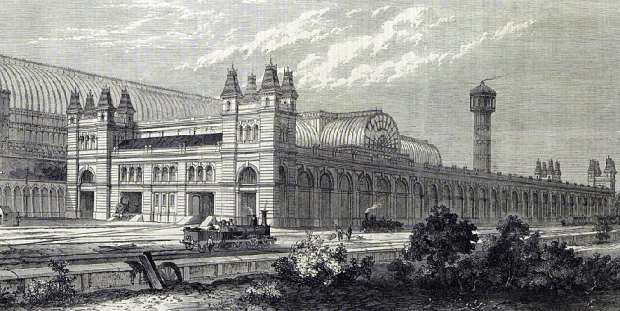
Crystal Palace High Level station, 1865. (Image: London Illustrated News).
If you look carefully however, a few remnants of the old station can still be glimpsed. Alongside the new homes, just below Crystal Palace Parade, you’ll find a long retaining wall, which once run parallel to the station.
If you peer over the opposite side of Crystal Palace Parade, you’ll spot the dilapidated remains of a once ornate subway which provided a direct walkway between the station and the palace itself.

Ariel view of the derelict subway (please note: there is no public access. Image: Google).
*
For those who wished to travel to the attraction by road, accommodation for three hundred horses-a sort of equine garage- was provided at the ‘Paxton Stables’, located behind the nearby Woodman Inn on Westow Hill, where your steed could rest for the price of one shilling and sixpence; “including a feed of corn and all other expenses.”
Today, ‘Joanna’s’ restaurant stands on the site of the old pub, although the cobbled road which led into to the horse facility can still be seen.
*
Park of delights
Inside the rebooted Crystal Palace there was a stunning amount for visitors to indulge in, with galleries showcasing art and culture from across the ages; Greek, Egyptian, Roman (including a court dedicated to the doomed town of Pompeii), Italian renaissance, Byzantine, Medieval and much more.
There were also galleries for musical instruments, fabrics, sculpture and various other modern technologies.
The surrounding gardens provided even more delights, with impressive arrays of flora, a park showcasing large dinosaur models (more of which in part two) and a system of powerful fountains which, when first inaugurated, were capable of firing jets of water 200ft into the air.
This impressive aquatic display was powered by two mighty water towers; each sanding 282 ft. high- 107 ft. taller than Nelson’s Column and designed by legendary engineer, Isambard Kingdom Brunel.
To keep the fountains operating at such levels, the towers were required to deal with a colossal 120,000 gallons of water per minute. However, it soon became apparent that the structures were unable to cope with such force and, fearing that the towers may rupture, the park’s owners had little choice but to wind the fountains down.
*
More successful of the outdoor features was the Pneumatic Railway; a short, experimental line linking one park gate to another.
The system consisted of an airtight pipe, sunk halfway into the ground, through which a single carriage was puffed from one end to the other- rather like a giant pea shooter.
Many visitors paid a few pence to ride this novelty but despite its popularity the railway remained open to the public for just one year. Its quick disappearance has since led to many an urban legend suggesting that the Victorian railcar lies buried somewhere deep beneath the park…
*
For the first thirty years at its new location, the Crystal Palace thrived, attracting an average of two million visitors per year.
Countless exhibitions were held; dog and cat shows, livestock shows, photography exhibitions, acrobatic displays, circuses, musical concerts and so on.
Firework extravaganzas were also popular and heads of state from across the globe came to enjoy the delights of the glistening landmark.
In 1911, the complex staged its biggest event ever; The Festival of Empire in which “representations of possessions beyond the seas”- such as Indian tea plantations, Australian vineyards and South African gold mines- sprang up around the park like a miniature, global village.
To help visitors access these dioramas, organizers laid down ‘The Red Route’; a mile and a half long electric railway with stations for each country.
Into the 20th century
Despite such extravagance, the Crystal Palace itself was struggling financially.
Since the turn of the century, the 1850s building- which it must be remembered had originally been designed to stand for a matter of months- was growing increasingly shabby.
Over the past decades, it had suffered fire and storm damage. Random panes of glass would often become loose and drop out and the framework required constant painting. The building’s vast size was proving too costly to maintain and, shortly after the Festival of Empire, the Crystal Palace was declared bankrupt.
War and a new lease of life
Eventually bailed out by the Earl of Plymouth, the huge venue stumbled back to its feet, making a few pounds on the side with newly installed banks of slot machines.
Another innovation was created by a chap called Edmund Dangerfield (editor of The Motor magazine) who, in one of the palace’s wings, set up the world’s very first museum dedicated to the motor-car.
Following the outbreak of WWI, the Crystal Palace and its surrounding park were closed to the public and commandeered by the military; the facilities being used to train 125,000 servicemen.
Due to the war emergency, the cars from Dangerfield’s motor museum were given little consideration; with those that could not be returned to their original donors being hastily dumped on waste ground near Charing Cross.
*
At the conclusion of the Great War the Crystal Palace found another role as a huge demob centre.
Once its duties to King and country were over, the attraction experienced a brief renaissance thanks to James Buckland; the newly installed manager who loved the Victorian icon so much that he’d named his daughter ‘Chrystal’.
During this period, the Crystal Palace provided a home for the very first incarnation of the Imperial War Museum; the weapons on display illustrating the horror of trench warfare which was still very fresh in people’s minds.
The Imperial War Museum remained at the Palace until 1924 before moving onto South Kensington and then Lambeth, where it has remained since 1936.
In the early 1930s, the Crystal Palace played an important role in the early history of television when the Scottish inventor, John Logie Baird decided to move his studio onto the premises, using Brunel’s two old water towers as masts for his antennas. To read more about Logie Baird’s London, please click here.
*
Farewell old friend
On the night of November 30th 1936, the legendary Crystal Palace came to a rapid and tragic end.
Just after 7pm, James Buckland- who lived nearby so he could keep a close eye on his cherished responsibility- was returning from an evening walk when he noticed a glow coming from the palace.
Rushing to the scene, he discovered staff attempting to extinguish a fire which, although small initially, was spreading faster than they could handle.
The flames quickly took hold, promptly engulfing the building in a mighty inferno. So intense was the blaze that its red haze could be seen as far away as Brighton and Margate, the disaster earning the awful title of Britain’s largest peace-time blaze.
Despite the exhaustive efforts of 430 firemen, 88 fire engines and 749 police officers the Crystal Palace was utterly destroyed; the London landmark turned into a smouldering ruin of twisted metal within a matter of hours.
A news-reel from the period covering the heartbreaking event can be viewed below.
The only features to survive the inferno were Brunel’s two water towers which remained in situ until the outbreak of WWII- when they were deliberately destroyed in what is believed to have been an attempt to thwart enemy bombers using the landmarks as navigational aids.

Happier days… Crystal Palace & one of Brunel’s water towers, as seen from Anerley Hill (image: Wikipedia).
*
Amongst the ruins…
Today, the site of the old Crystal Palace on the park’s western edge is an eerie, melancholy place characterized by windswept staircases and lonely statues; many of which have been callously vandalized.
In 1953, American poet, James Broughton used the atmospheric ruins as the backdrop to his short, avant-garde film, The Pleasure Garden which featured Hattie Jacques and John Le Mesurier and sought to inject a little cheer into post-war Britain…


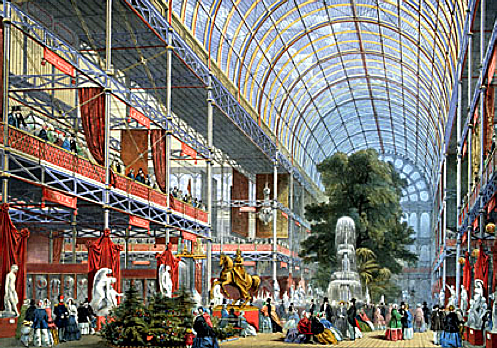
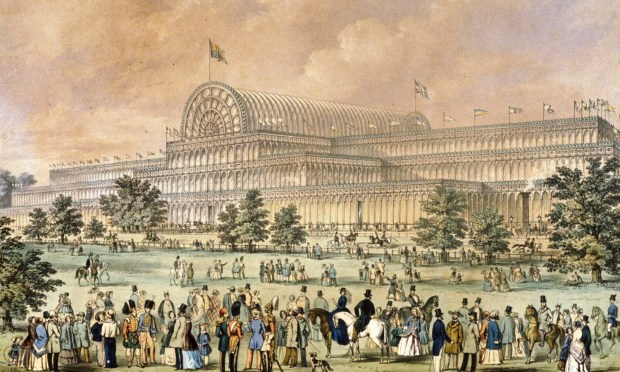


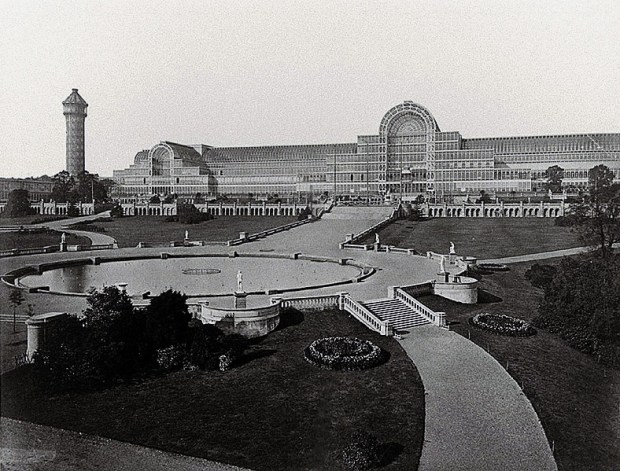







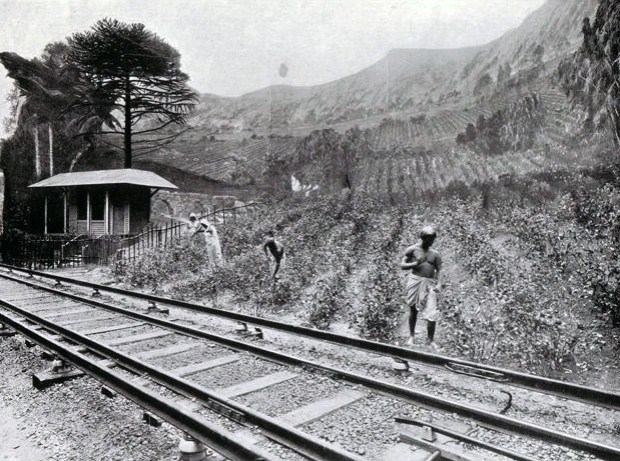












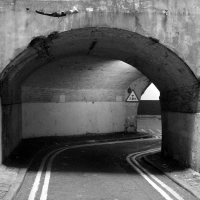








Thanks, great article once again. Looking forward to part 2
Thanks, Damian glad you enjoyed it.
Excellent! I grew up there – I knew some but certainly not all of that – great post!
Many thanks, Kevin- much appreciated 🙂
[…] The history of Crystal Palace Park. […]
Great post! I am a Brazilian living in London for a year now.. I’ve always read stuff about the Crystal Palace. I haven’t been to the park yet but I will for sure this year. It reminds me (a bit) of Alexandra Palace. Love this buildings 🙂
Many thanks for the kind words, Andreh. There is certainly a rivalry between Alexandra Park and Crystal Palace Park!
Hope you’re enjoying life in London, it’s always a pleasure to meet Brazilian friends 🙂
Thanks again.
Very interesting! Thanks. Looking forward to part 2.
Thanks 🙂
I’ve been meaning to get to the park to explore and it keeps being forgotten on my ever expanding list of things to do. Thanks for the reminder and waiting for the second part!
No worries! Now is a great time to visit as the weather is finally improving 🙂
Fantastic – it bought tears to my eye, especially the newsreel footage.
I’ve always had a huge soft spot for Crystal Palace and am honoured to be lucky enough to be moving to Sydenham Hill very shortly. The place just has a magical property that can’t be explained in words.
Looking forward to part 2!
That’s a really kind comment, Aidan. Many thanks. Hope you have a wonderful life in your new home.
Another great post, I’d read quite a bit about the original exhibition in Hyde Park but knew nothing of the crystal palaces new life, other than it moved and eventually burnt down, thank you for telling the story, another place on the list to visit!
Many thanks, Richard 🙂
Another great post, You mention dinosaurs in the park, i remember going to see the more modern fiberglass ones when i was young in the 70’s.
Also, talking of the Geat Exhibition, am i right in thinking that it is due to this that the “Knowledge of London ” was born?
Thanks, Richard.
You’re 100% correct; the Great Exhibition did indeed lead to the Knowledge. Because so many people visited London, it became apparent that a lot of the cabbies didn’t know where they were going! Legend has it that Prince Albert came up with the idea of testing us.
Thanks again 🙂
I always wondered (though not enough to find out…) who the person on the plinth was. So thanks for that.
Crystal Palace is one of my favourite London parks, although I always have to go downhill, rather than up.
Nice article once again. I thoroughly enjoyed my nomadic expedition that was the KOL. One of my favorite areas to go pointing was Crystal Palace, perched on the edge of the 6 mile and the borders of the dark side suburbs. I remember discovering the stunning hidden Norwood Grove mansion and its remarkable views across the Surrey Hills from my trusty steed, C90.
Thanks, Sam. I know exactly what you mean.
[…] (To read the first part of this history on Crystal Palace Park, please click here.) […]
I grew up a stones throw from the site in the 1950/60s.. the crystal Palace is in my DNA, wish I’d seen it.
Many thanks. for sharing this.
Nice comment, James. Many thanks.
I was born in Penge very close to the Crystal Palace. During my childhood in the 1950s my brother and I spent many hours playing in the ruins of the gardens. We climbed the steps and over fallen statues. My friends father had a piece of molten glass that he had picked up after the fire. Happy memories.
Thanks for sharing those memories, Sandra- it’s always good to meet people who have a direct link with these wonderful places. I’d give anything for a piece of molten glass from the old palace, hope your friend still has it in the family!
[…] by a recent demonstration at the newly located Crystal Palace in Sydenham, this early tube link was intended to be a pneumatic railway- “noiseless and free […]
Thank you! Do you have a date for the photo of the water towers?
Hi Rosie, I’m not too sure about the date but I’m pretty sure the photo was taken around the 1920s.